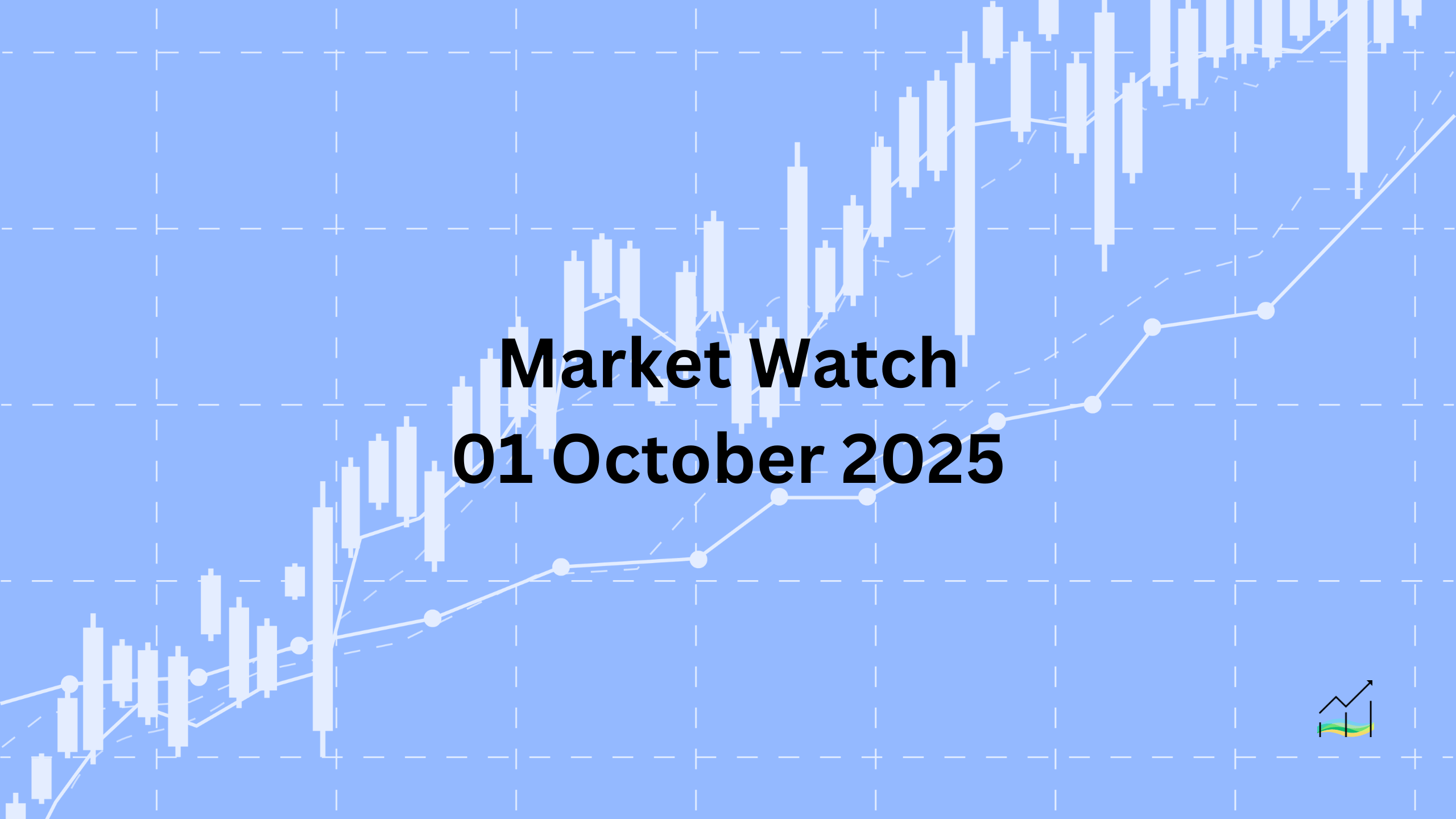01/10/2025 Market Watch

U.S. Government Shutdown Looms Over Markets as Gold Surges to Record
Key Takeaways:
- Partial US government shutdown underway with risk of prolongation.
- Dollar steady against majors, firmer versus emerging market currencies.
- Yen strength weighs on Japan equities, broader Asia mixed.
- European equities extend gains, US futures softer.
- Gold hits record above $3895, oil extends pullback below $62.
The United States has entered a partial government shutdown after lawmakers failed to approve appropriations for the new fiscal year. The president has signaled an uncompromising stance by threatening permanent job cuts for non-essential federal workers. Around 150,000 employees have already accepted government buyouts. Historical precedent shows shutdowns can last weeks, with the longest stretching to 35 days in 2019, raising concerns this disruption could also be protracted.
The dollar is steady against major currencies after early selling, though it shows strength against emerging market currencies. The yen continues to lead the G10 space, its recent rally weighing on Japanese equities. Elsewhere in Asia, markets are mixed with gains in the broader region, though China and Hong Kong remain closed for national holidays. Australia stands out as an underperformer.
In Europe, the Stoxx 600 is advancing for the fourth consecutive session, matching its longest streak since May. US index futures are pointing lower by around 0.50% to 0.60%, but history suggests shutdowns have not been persistently negative for equity performance. Bond markets remain calm, with European 10-year yields modestly higher by 1 to 2 basis points, while the US 10-year Treasury yield is stable just below 4.15%.
Commodities show greater volatility. Gold has surged to a record above $3895, up sharply from $3760 at the end of last week, highlighting strong safe-haven demand. Oil continues to retreat, with November WTI futures sliding below $62 after recently touching above $66. The decline places it near last month’s lows, reflecting both demand concerns and supply dynamics.
United States of America
Overview
The Dollar Index has extended its three-day pullback, testing the 50% retracement level of the post-FOMC rally near 97.40 after meeting the 38.2% retracement at 97.70. The next level of support lies just below 97.15, marking the 61.8% retracement. The 97.70 to 97.80 range now represents the immediate cap.
With much of the federal government closed, the market’s attention is shifting to private sector data for guidance. Key reports such as the Mortgage Bankers Association’s weekly mortgage applications, the September final manufacturing PMI, the ISM manufacturing survey, and auto sales will provide insight into the current state of the economy. The ADP private payrolls report takes center stage, given its strong record of anticipating the official BLS estimates.
In terms of labor market dynamics, ADP has shown slightly higher job creation compared to the BLS over the past two years. From January to August 2024, ADP estimated monthly private sector job growth at just over 144k, compared with 130k reported by the BLS. Auto sales data, meanwhile, remain firm, with expectations for an annualized pace of 16.2 million in September, close to the August average of 16.26 million and above the 15.52 million pace recorded in the same period of 2023.
Economic Drivers
- Government shutdown has shifted focus to private sector data as official releases are delayed or limited.
- Labor market strength remains a key driver, with ADP providing timely insight relative to BLS payrolls.
- Auto sector shows resilience, with sales running above last year’s pace, suggesting continued consumer demand.
- Broader US manufacturing sentiment to be gauged through PMI and ISM results.
Data and Events
- 01 October 2025: ADP Non-Farm Employment Change
- 01 October 2025: ISM Manufacturing PMI & Price
Price Action
- Dollar Index retraced to 50% support near 97.40, with next downside target at 97.15.
- Resistance is seen in the 97.70-97.80 range, which may cap recovery attempts.
Key Points:
- Dollar Index under pressure, testing key retracement levels.
- Shutdown highlights importance of private sector data.
- ADP jobs report expected to guide payroll expectations.
- Auto sales remain strong, above last year’s levels.
- Near-term dollar resistance stands around 97.70-97.80.
Australia
Overview
The Australian dollar has gained support from a combination of a hawkish hold by the Reserve Bank of Australia and broad weakness in the US dollar. The currency briefly approached $0.6630 yesterday, with today’s high near $0.6620. The 61.8% retracement of its rally since the Federal Reserve’s recent rate cut sits just above at $0.6635, while additional resistance lies around $0.6665. The yearly high, recorded on September 17, was slightly above $0.6705.
On the domestic front, Australia’s September manufacturing PMI eased to 51.4 from the preliminary 51.6 and down from 53.0 in August. Despite the decline, it remains one of the few G10 economies with a manufacturing PMI still above the 50 threshold, indicating continued expansion. Looking ahead, the August goods trade balance and household spending figures will be released tomorrow. Goods trade surpluses have averaged A$4.67 billion this year, nearly 25% smaller than in the first seven months of 2024. Household spending is projected to rise 0.3% in August, slightly weaker than the average pace recorded earlier this year.
Economic Drivers
- RBA’s hawkish hold reinforces policy divergence and supports the currency.
- Australian manufacturing remains resilient, with PMI still in expansion territory despite easing.
- Slower goods trade surplus growth compared to 2024 reflects changing external dynamics.
- Household consumption trends remain steady but are showing signs of moderation.
Data and Events
No major economic releases are scheduled today.
Price Action
- Australian dollar reached $0.6630 yesterday and $0.6620 today.
- Key resistance levels: $0.6635 (61.8% retracement), $0.6665, and yearly high near $0.6705.
- Support remains tied to the broader US dollar trend and domestic resilience.
Key Points:
- RBA’s hawkish hold has supported AUD strength.
- Australian dollar testing resistance around $0.6630.
- Manufacturing PMI slowed but remains in expansion.
- Trade surplus smaller than 2024 averages.
- Household spending growth expected at 0.3% in August.
Canada
Overview
The US dollar has extended its decline against the Canadian dollar for a third straight session, briefly slipping below CAD1.3900 yesterday before stabilising above it today. The pair has so far been capped at CAD1.3935, with the 38.2% retracement of post-FOMC and Bank of Canada rate cut gains resting near CAD1.3870.
Despite this latest move, the Canadian dollar has generally underperformed in softer US dollar environments. In September, it fell around 1.2%, second only to the New Zealand dollar’s 1.5% decline. Over the first three quarters of the year, all G10 currencies have strengthened against the US dollar, but the Canadian dollar’s 3.4% gain is the smallest.
Domestically, the September manufacturing PMI will be released today. While not a key market driver, it has shown modest improvement in recent months. At 48.3, it is at its highest level since January, when it last managed to stay above the 50 threshold.
Economic Drivers
- Canadian dollar underperformed in Q3, gaining the least among G10 currencies against the US dollar.
- September weakness reflects sensitivity to broader US dollar trends.
- Manufacturing sector remains subdued, though PMI is at its highest level since January.
- Limited domestic catalysts, leaving external forces as the dominant driver.
Data and Events
- 01 October 2025: Manufacturing PMI
Price Action
- US dollar briefly traded below CAD1.3900, holding between CAD1.3900 and CAD1.3935 today.
- Key support lies at CAD1.3870 (38.2% retracement).
- Resistance capped at CAD1.3935, with broader momentum linked to US dollar direction.
Key Points:
- Canadian dollar remains one of the weakest G10 performers.
- September decline of 1.2% highlights relative underperformance.
- Year-to-date gain of 3.4% is the lowest in the G10.
- September PMI at 48.3 shows modest improvement but still below expansion.
- Price action capped within CAD1.3870 to CAD1.3935 range.
China
Overview
Mainland markets remain closed for the extended national holiday and will re-open on Thursday, October 9. In the meantime, developments in trade and geopolitics continue to shape sentiment around China. While the prevailing US narrative often highlights China’s dependence on American markets and agricultural imports, Chinese trade dynamics tell a different story. Despite reduced exports to the US, China’s overall trade surplus has expanded.
Beijing has diversified its import base, replacing US soybeans with supplies from Brazil and Argentina, and shifting beef imports toward Australia. At the same time, it has discouraged the use of Nvidia’s H20 AI chip, citing security risks, underscoring its intent to reduce reliance on US technology. However, high-income economies remain heavily dependent on China for processed rare earths and magnets, giving Beijing leverage in critical supply chains.
On the geopolitical front, reports suggest Beijing requested that Washington formally decline to state it "opposes" Taiwan independence. This is a stronger stance than the Biden administration’s existing position that the US does not support Taiwan seeking formal independence, signaling China’s willingness to press harder on sensitive diplomatic issues.
Economic Drivers
- Diversification of agricultural imports away from the US toward Brazil, Argentina, and Australia.
- Growth in China’s trade surplus despite weaker exports to the US.
- Strategic discouragement of Nvidia’s H20 AI chip on security grounds.
- Continued global reliance on China for processed rare earths and magnets.
- Heightened geopolitical tension with Washington over Taiwan-related rhetoric.
Data and Events
No major economic releases are scheduled today.
Price Action
- Offshore yuan has been stable during the holiday period.
- Expected trading range remains within CNH7.11-CNH7.15.
- Today’s intraday range has been CNH7.1230-CNH7.1400.
Key Points:
- Mainland markets closed until October 9.
- China’s trade surplus continues to grow despite lower US exports.
- Diversification of key imports reduces reliance on US agricultural products.
- Rare earths and magnets remain critical leverage for China.
- Yuan stability persists within a narrow offshore range.
Europe
Overview
The euro strengthened to a new five-day high near $1.1780 today, supported by recent economic data and broad market positioning. The move comes as the currency approaches important retracement levels of its decline since setting a four-year high around $1.1920 following the FOMC statement on September 17. While the euro has room to test higher levels, the $1.1730-50 range now serves as key support.
Inflation data across the bloc’s four largest economies fed into the eurozone’s aggregate September CPI, which rose 0.1% on the month and 2.2% year-over-year. Core inflation remained steady at 2.3%, indicating underlying price pressures are not easing further for now. Meanwhile, the final manufacturing PMI was revised slightly higher to 49.8 from the preliminary 49.5, though it still marked the first contraction of the year. This follows August’s move above the 50 threshold for the first time since before Russia’s invasion of Ukraine, highlighting continued fragility in the manufacturing sector.
Economic Drivers
- Eurozone CPI rose 0.1% in September, with annual inflation at 2.2%.
- Core inflation steady at 2.3%, suggesting persistent underlying price pressures.
- Manufacturing PMI revised to 49.8, confirming contraction and underscoring weakness in industry.
- Euro supported by expectations around monetary policy stability and relative resilience against the US dollar.
Data and Events
- 01 October 2025: Final Manufacturing PMI
- 01 October 2025: CPI Flash Estimate
Price Action
- Euro reached a five-day high near $1.1780.
- Key resistance at $1.1815 (61.8% retracement of recent losses).
- Initial support lies in the $1.1730-50 zone.
- The 50% retracement of post-FOMC losses sits just above current levels.
Key Points:
- Euro climbs to five-day high near $1.1780.
- September CPI shows 2.2% annual rise, with core at 2.3%.
- Manufacturing PMI revised to 49.8, confirming contraction.
- Support at $1.1730-50, resistance at $1.1815.
- Broader inflation and growth dynamics continue to shape outlook.
Japan
Overview
The yen has strengthened further as the dollar posted a fourth consecutive daily decline, slipping to its lowest level since September 18. The move overshot the 61.8% retracement of the dollar’s gains following the FOMC meeting, with today’s low near JPY146.90. The yen’s momentum reflects both market positioning and shifting expectations around Bank of Japan policy.
The BoJ’s Tankan survey released earlier today showed little change compared with Q2, but the standout detail was the upward revision in capital expenditure projections. Large industry capex estimates for the fiscal year were raised to 12.5% from 11.5%, pointing to stronger corporate investment appetite. However, the manufacturing outlook remains subdued. The September PMI was revised slightly higher to 48.5 from 48.4, but still marked the weakest reading since March 2024 and reflected the sharpest monthly decline since November 2022.
Interest rate expectations are also adjusting. At the end of August, swaps priced slightly more than a 50% chance of a BoJ rate hike this month. Entering Q4, those odds have climbed to just under 63%, underscoring growing conviction that policymakers may act.
Economic Drivers
- Tankan survey broadly stable, but corporate capital expenditure estimates revised higher to 12.5%.
- Manufacturing PMI at 48.5, its lowest since March 2024, indicating persistent weakness in the industrial sector.
- Sharpest PMI monthly drop since November 2022 highlights deteriorating momentum.
- Market pricing increasingly reflects a potential BoJ rate hike, with odds rising to nearly 63%.
Data and Events
- 01 October 2025: Tankan Manufacturing & Non-Manufacturing Index
- 01 October 2025: Final Manufacturing PMI
Price Action
- Dollar extended losses to JPY146.90, the lowest since September 18.
- Overshot key retracement support at JPY147.20.
- Yen strength reinforced by rising BoJ policy expectations.
Key Points:
- Dollar falls to fourth straight daily loss against yen.
- Tankan survey steady, but capex forecasts revised higher.
- Manufacturing PMI signals sharpest decline since late 2022.
- BoJ hike odds rise to nearly 63% for October.
- Yen momentum continues with support from policy expectations.
United Kingdom
Overview
Sterling strengthened for the fourth consecutive session, reaching $1.3480 and meeting the 38.2% retracement of its post-FOMC losses. The next levels to watch are the 20-day moving average around $1.3500 and the 50% retracement near $1.3525. The pound’s resilience reflects shifting sentiment around the Bank of England’s policy outlook as domestic data provides a mixed picture.
The housing market showed a surprise improvement, with the Nationwide house price index rising to 2.2% in September from 2.1%. Expectations had been for a dip below 2% for the first time since June 2023. However, the manufacturing sector continues to struggle. September’s PMI was confirmed at 46.2, its weakest reading since March and the twelfth consecutive month below the 50 threshold, highlighting persistent contraction.
Concerns around stagflation are more commonly raised in the US context, but the UK faces its own challenges with weaker growth and higher inflation than the US. The Bank of England has made clear it is in no rush to cut rates again, with swaps pricing the next move not fully until mid-Q2 2026.
Economic Drivers
- Nationwide house price index rose unexpectedly to 2.2% in September, signaling resilience in the housing market.
- Manufacturing PMI stuck in contraction at 46.2, weakest since March, marking a year below 50.
- UK growth remains weaker than in the US while inflation remains higher.
- Bank of England signals patience, with markets not expecting another cut until mid-2026.
Data and Events
- 01 October 2025: Final Manufacturing PMI
Price Action
- Sterling extended gains to $1.3480, its fourth consecutive rise.
- Resistance seen at $1.3500 (20-day moving average) and $1.3525 (50% retracement).
- Continued upside momentum supported by policy expectations and relative dollar weakness.
Key Points:
- Sterling up for fourth straight session, reaching $1.3480.
- Housing index stronger than expected at 2.2%.
- Manufacturing PMI weak at 46.2, in contraction for a year.
- UK growth weaker and inflation higher compared to the US.
- BoE unlikely to cut rates again until mid-2026.
© 2025 SKONE Enterprise (003319453-V). All rights reserved.
The content on this site is for informational purposes only and does not constitute financial advice.


